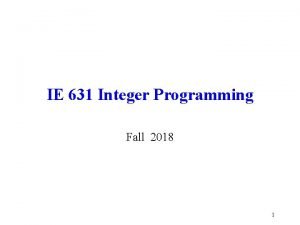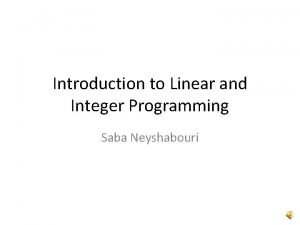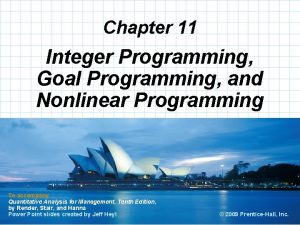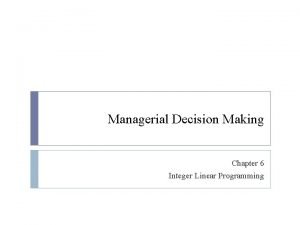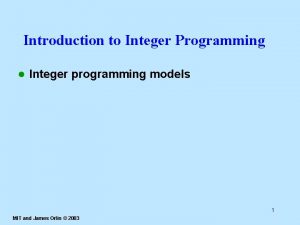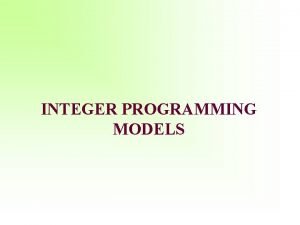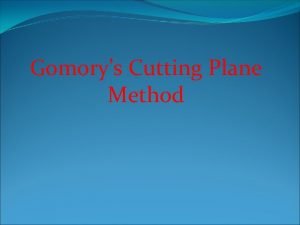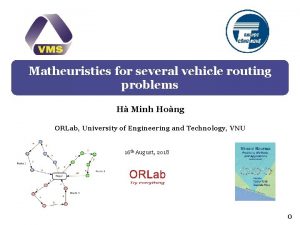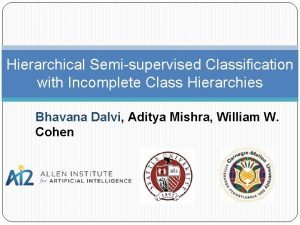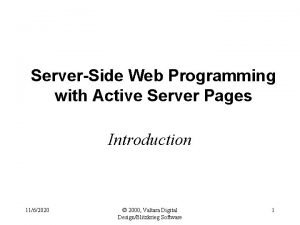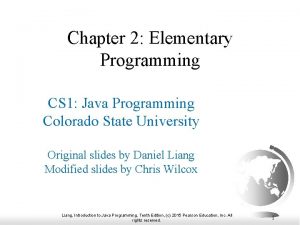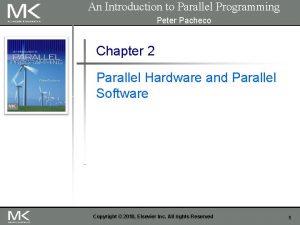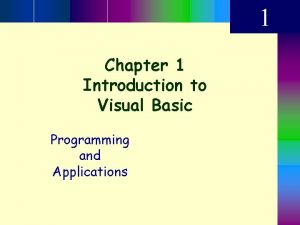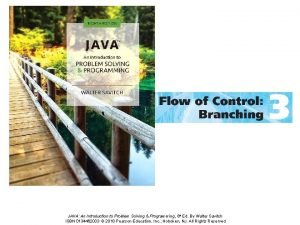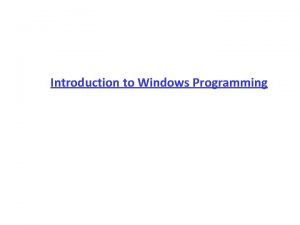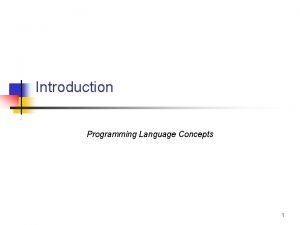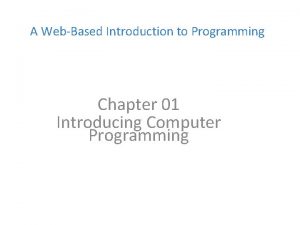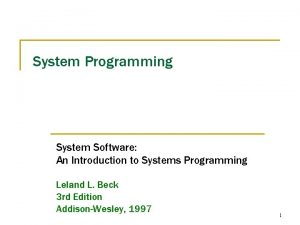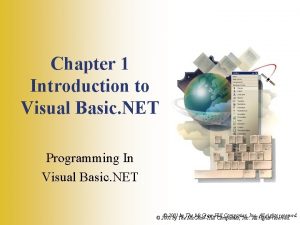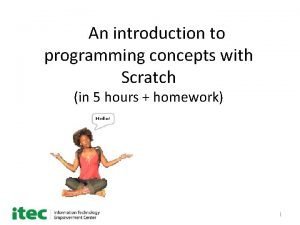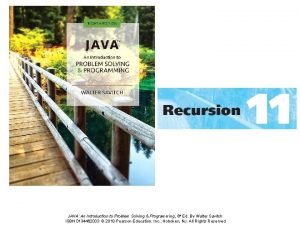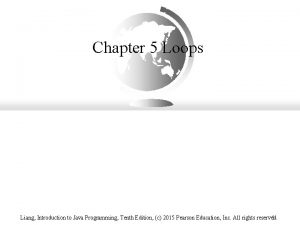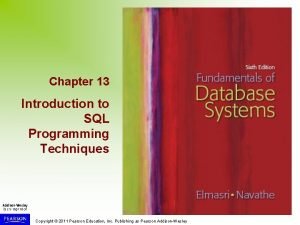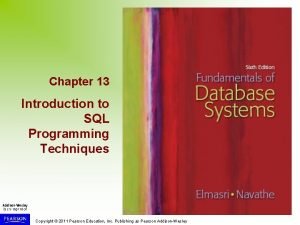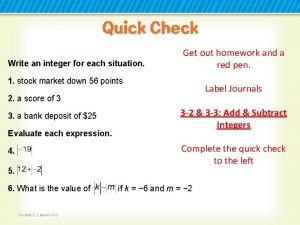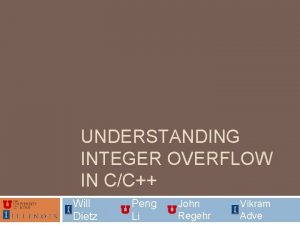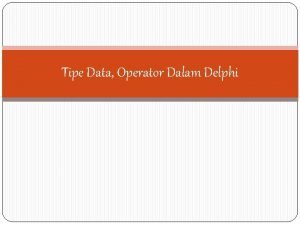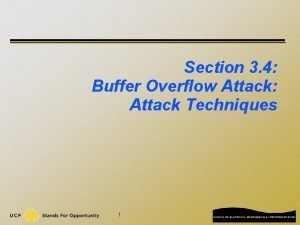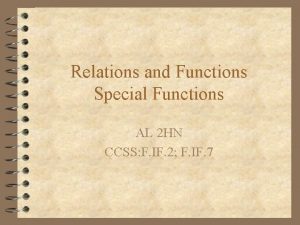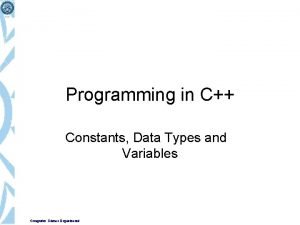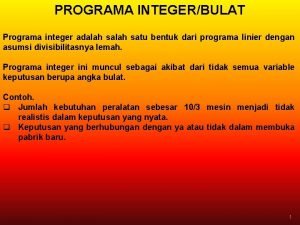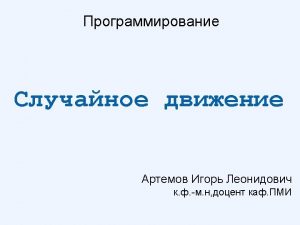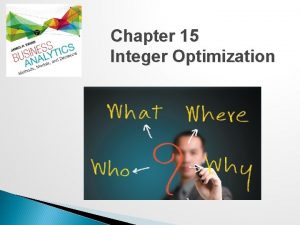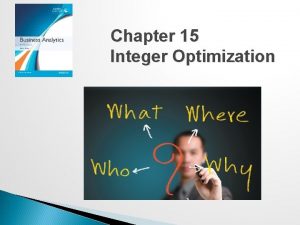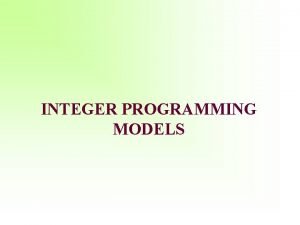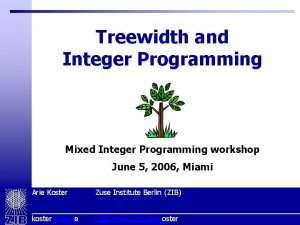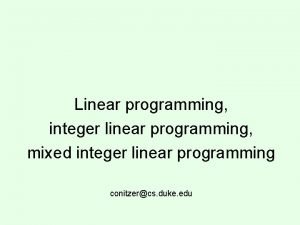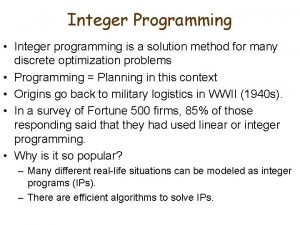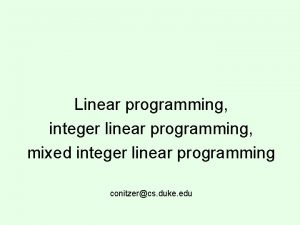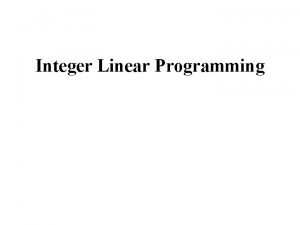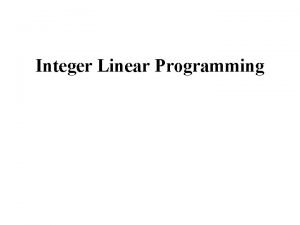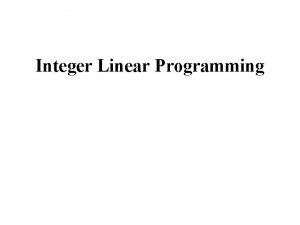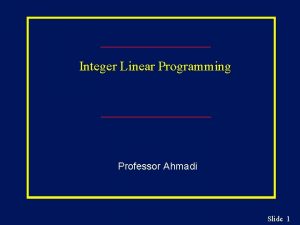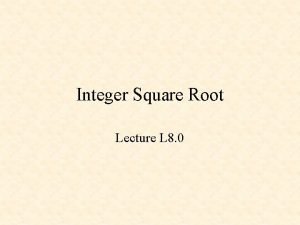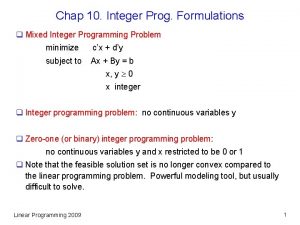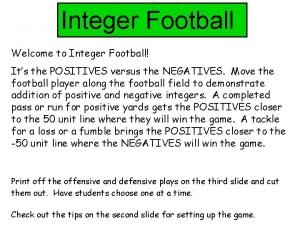Integer Programming l Introduction to Integer Programming IP






















































- Slides: 54

Integer Programming l Introduction to Integer Programming (IP) l Difficulties of LP relaxation l IP Formulations l Branch and Bound Algorithms 0

Integer Programming Model l An Integer Programming model is a linear programming problem where some or all of the variables are required to be non-negative integers. l These models are in general substantially harder than solving linear programming models. l Network models are special cases of integer programming models and are very efficiently solvable. l We will discuss several applications of integer programming models. l We will study the branch and bound technique, one of the most popular algorithm to solve integer programming models. 1

Classifications of IP Models Pure IP Model: Where all variables must take integer values. Maximize subject to z = 3 x 1 + 2 x 2 x 1 + x 2 £ 6 x 1, x 2 0, x 1 and x 2 integer Mixed IP Model: Where some variables must be integer while others can take real values. Maximize subject to z = 3 x 1 + 2 x 2 x 1 + x 2 £ 6 x 1, x 2 0, x 1 integer 0 -1 IP Model: Where all variables must take values 0 or 1. Maximize subject to z = x 1 - x 2 x 1 + 2 x 2 £ 2 2 x 1 - x 2 £ 1, x 2 = 0 or 1 2

Classifications of IP Models (contd. ) LP Relaxation: The LP obtained by omitting all integer or 0 -1 constraints on variables is called the LP relaxation of IP. IP: Maximize z = 21 x 1 + 11 x 2 subject to 7 x 1 + 4 x 2 £ 13 x 1, x 2 0, x 1 and x 2 integer LP Relaxation: Maximize z = 21 x 1 + 11 x 2 subject to 7 x 1 + 4 x 2 £ 13 x 1, x 2 0 Result: Optimal objective function value of IP £ Optimal objective function value of LP relaxation 3

IP and LP Relaxation x x 2 x 1 7 x 1 + 4 x 2= 13 x x 2 3 x x x 1 2 x 1 4 x 3

Simple Approaches for Solving IP Approach 1: l Enumerate all possible solutions l Determine their objective function values l Select the solution with the maximum (or, minimum) value. Any potential difficulty with this approach? -- may be time-consuming Approach 2: l Solve the LP relaxation l Round-off the solution to the nearest feasible integer solution Any potential difficulty with this approach? -- may not be optimal solution to the original IP 5

The use of binary variables in constraints l Any decision situation that can be modeled by “yes”/“no”, “good”/“bad” etc. , falls into the binary category. l To illustrate 6

The use of binary variables in constraints l Example u A decision is to be made whether each of three plants should be built (Y i = 1) or not built (Yi = 0) Requirement Binary Representation Y 1 + Y 2 +Y 3 2 At least 2 plants must be built If plant 1 is built, plant 2 must not be built Y 1 + Y 2 £ 1 If plant 1 is built, plant 2 must be built Y 1 – Y 2 £ 0 One, but not both plants must be built Y 1+ Y 2 = 1 Both or neither plants must be built Y 1 – Y 2 =0 Plant construction cannot exceed $17 million given the costs to build plants are $5, $8, $10 million 5 Y 1+8 Y 2+10 Y 3 £ 17 7

Capital Budgeting Problem l Stockco Co. is considering four investments l It has $14, 000 available for investment l Formulate an IP model to maximize the NPV obtained from the investments IP: Maximize subject to z = 16 x 1 + 22 x 2 + 12 x 3 + 8 x 4 5 x 1 + 7 x 2 + 4 x 3 + 3 x 4 £ 14 x 1, x 2, , x 3, x 4 = 0, 1 8

Fixed Charge Problem l Gandhi cloth company manufactures three types of clothing: shirts, shorts, and pants l Machinery must be rented on a weekly basis to make each type of clothing. Rental Cost: u $200 per week for shirt machinery u $150 per week for shorts machinery u $100 per week for pants machinery l There are 150 hours of labor available per week and 160 square yards of cloth l Find a solution to maximize the weekly profit 9

Fixed Charge Problem (contd. ) Decision Variables: x 1 = number of shirts produced each week x 2 = number of shorts produced each week x 3 = number of pants produced each week y 1 = 1 if shirts are produced and 0 otherwise y 2 = 1 if shorts are produced and 0 otherwise y 3 = 1 if pants are produced and 0 otherwise Formulation: Max. z = 6 x 1 + 4 x 2 + 8 x 3 - 200 y 1 - 150 y 2 - 100 y 3 subject to 3 x 1 + 2 x 2 + 6 x 3 £ 150 4 x 1 + 3 x 2 + 4 x 3 £ 160 x 1 £ M y 1 , x 2 £ M y 2 , x 3 £ M y 3 x 1, x 2, , x 3 0, and integer; y 1, y 2, , y 3 = 0 or 1 10

Either-Or Constraints l Dorian Auto is considering manufacturing three types of auto: compact, midsize, large. l Resources required and profits obtained from these cars are given below. l We have 6, 000 tons of steel and 60, 000 hours of labor available. l If any car is produced, we must produce at least 1, 000 units of that car. l Find a production plan to maximize the profit. 11

Either-Or Constraints (contd. ) Decision Variables: x 1, x 2, x 3 = number of compact, midsize and large cars produced y 1, y 2, y 3 = 1 if compact , midsize and large cars are produced or not Formulation: Maximize z = 2 x 1 + 3 x 2 + 4 x 3 subject to x 1 £ My 1; x 2 £ My 2; x 3 £ My 3 1000 - x 1 1000 - x 2 1000 - x 3 1. 5 x 1 + 3 x 2 + 5 x 3 30 x 1 + 25 x 2 + 40 x 3 £ M(1 -y 1) £ M(1 -y 2) £ M(1 -y 3) £ 60000 x 1, x 2, x 3 0 and integer; y 1, y 2, y 3 = 0 or 1 12

Set Covering Problems l Western Airlines has decided to have hubs in USA. l Western runs flights between the following cities: Atlanta, Boston, Chicago, Denver, Houston, Los Angeles, New Orleans, New York, Pittsburgh, Salt Lake City, San Francisco, and Seattle. l Western needs to have a hub within 1000 miles of each of these cities. l Determine the minimum number of hubs 13

Formulation of Set Covering Problems Decision Variables: xi = 1 if a hub is located in city i xi = 0 if a hub is not located in city i Minimize x. AT + x. BO + x. CH + x. DE + x. HO + x. LA + x. NO + x. NY + x. PI + x. SL + x. SF + x. SE subject to 14

Additional Applications l Location of fire stations needed to cover all cities l Location of fire stations to cover all regions l Truck dispatching problem l Political redistricting l Capital investments 15

Branch and Bound Algorithm l Branch and bound algorithms are the most popular methods for solving integer programming problems l They enumerate the entire solution space but only implicitly; hence they are called implicit enumeration algorithms. l A general-purpose solution technique which must be specialized for individual IP's. l Running time grows exponentially with the problem size, but small to moderate size problems can be solved in reasonable time. 16

Example: s. t. 17

Solved as LP by Simplex method 18

An Example l Telfa Corporation makes tables and chairs l A table requires one hour of labor and 9 square board feet of wood l A chair requires one hour of labor and 5 square board feet of wood l Each table contributes $8 to profit, and each chair contributes $5 to profit. l 6 hours of labor and 45 square board feet is available l Find a product mix to maximize the profit Maximize z = 8 x 1 + 5 x 2 subject to x 1 + x 2 £ 6; 9 x 1 + 5 x 2 £ 45; x 1, x 2 0; x 1, x 2 integer 19

Feasible Region for Telfa’s Problem Subproblem 1 : The LP relaxation of original Optimal LP Solution: x 1 = 3. 75 and x 2 = 2. 25 and z = 41. 25 Subproblem 2: Subproblem 1 + Constraint x 1 4 Subproblem 3: Subproblem 1 + Constraint x 1 £ 3 20

Feasible Region for Subproblems Branching : The process of decomposing a subproblem into two or more subproblems is called branching. Optimal solution of Subproblem 2: z = 41, 1. 8 x 1 = 4, x 2 = 9/5 = Subproblem 4: Subproblem 2 + Constraint x 2 2 Subproblem 5: Subproblem 2 + Constraint x 2 £ 1 21

Feasible Region for Subproblems 4 & 5 22

The Branch and Bound Tree 1 Subproblem 1 z = 41. 25 x 1 = 3. 75 x 2 = 2. 25 x 1 £ 3 x 1 4 2 Subproblem 2 z = 41 x 1 = 4 x 2 = 1. 8 x 2 £ 1 x 2 2 3 Subproblem 4 Infeasible Subproblem 5 4 Optimal solution of Subproblem 5: z = 40. 05, x 1 = 4. 44, x 2 = 1 Subproblem 6: Subproblem 5 + Constraint x 1 5 Subproblem 7: Subproblem 5 + Constraint x 1 £ 4 23

Feasible Region for Subproblems 6 & 7 Optimal solution of Subproblem 7: z = 37, x 1 = 4, x 2 = 1 Optimal solution of Subproblem 6: z = 40, x 1 = 5, x 2 = 0 24

The Branch and Bound Tree 1 x 1 4 2 Subproblem 3 z = 39 x 1 = 3 x 2 = 3, 7 x 2 £ 1 Subproblem 4 Infeasible 6 x 1 £ 3 Subproblem 2 z = 41 x 1 = 4 x 2 = 1. 8 x 2 2 3 Subproblem 1 z = 41. 25 x 1 = 3. 75 x 2 = 2. 25 Subproblem 5 z = 40. 55 x 1 = 4. 44 x 2 = 1 4 Subproblem 7 z = 37 x 1 = 4 x 2 = 1 Subproblem 6 z = 40 x 1 = 5 x 2 = 0, 25 5

Solving Knapsack Problems Max z = 16 x 1+ 22 x 2 + 12 x 3 + 8 x 4 subject to 5 x 1+ 7 x 2 + 4 x 3 + 3 x 4 £ 14 xi = 0 or 1 for all i = 1, 2, 3, 4 LP Relaxation: Max z = 16 x 1+ 22 x 2 + 12 x 3 + 8 x 4 subject to 5 x 1+ 7 x 2 + 4 x 3 + 3 x 4 £ 14 0 £ xi £ 1 for all i = 1, 2, 3, 4 Solving the LP Relaxation: l Order xi’s in the decreasing order of ci/ai where ci are the cost coefficients and ai’s are the coefficients in the constraint ( Here: x 1→x 2 → x 3 → x 4) l Select items in this order until the constraint is satisfied with equality 26

The Branch and Bound Tree Subproblem 1 z = 44 x 1 = x 2 = 1 x 3 =. 5 1 x 3 = 0 7 x 4 = 0 8 Subproblem 3 z = 43. 7 x 1 =x 3= 1, x 2 =. 7, x 4=0 Subproblem 2 z = 43. 3, LB=42 x 1 = x 2=1 x 3 = 0, x 4 =. 67 Subproblem 8 z = 38, LB=42 x 1 = x 2=1 x 3 = x 4 = 0 x 2 = 1 x 2 = 0 x 4 = 1 3 Subproblem 4 z = 36 x 1 = x 3=1 x 2 = 0, x 4 =1 Subproblem 9 z= 42. 85, LB=42 x 1 = x 4 =1 9 x 3 = 0, x 2 =. 85 x 1 = 0 5 Subproblem 6 z = 42 x 1 =0, x 2=x 3=1 x 4 = 1, LB = 42 27 2 4 Subproblem 5 z = 43. 6 x 1 =. 6, x 2=x 3=1 x 4 = 0, LB = 36 x 1 = 1 Subproblem 7 LB = 42 6 Infeasible

Strategies of Branch and Bound The branch and bound algorithm is a divide and conquer algorithm, where a problem is divided into smaller and smaller subproblems. Each subproblem is solved separately, and the best solution is taken. Lower Bound (LB): Objective function value of the best solution found so far. Branching Strategy : The process of decomposing a subproblem into two or more subproblems is called branching. 28

Strategies of Branch and Bound (contd. ) Upper Bounding Strategy: The process of obtaining an upper bound (UB) for each subproblem is called an upper bounding strategy. Pruning Strategy: If for a subproblem, UB £ LB, then the subproblem need not be explored further. (Illustrate how to fathom nodes in a search tree ) Searching Strategy: The order in which subproblems are examined. Popular search strategies: LIFO and FIFO. 29








37


39

40




44

45

46

47

48

49

50

51

52

53
 What is an integer
What is an integer Perbedaan linear programming dan integer programming
Perbedaan linear programming dan integer programming Integer programming vs linear programming
Integer programming vs linear programming Perbedaan linear programming dan integer programming
Perbedaan linear programming dan integer programming Linear vs integer programming
Linear vs integer programming Integer programming course
Integer programming course Saba neyshabouri
Saba neyshabouri Integer programming problem
Integer programming problem Fixed charge problem integer programming
Fixed charge problem integer programming Integer programming mit
Integer programming mit Integer programming example
Integer programming example Cutting plane method integer programming
Cutting plane method integer programming Milp model
Milp model Mixed integer linear programming
Mixed integer linear programming Application of integer programming
Application of integer programming Mixed integer linear programming
Mixed integer linear programming Mixed integer linear programming
Mixed integer linear programming Greedy vs dynamic programming
Greedy vs dynamic programming System programming
System programming Introduction to server side programming
Introduction to server side programming Problem solving
Problem solving Introduction to programming languages
Introduction to programming languages Elementary programming in java
Elementary programming in java An introduction to parallel programming peter pacheco
An introduction to parallel programming peter pacheco Introduction to visual basic programming
Introduction to visual basic programming What does plc stand for? *
What does plc stand for? * Programming and problem solving with java
Programming and problem solving with java Introduction to windows programming
Introduction to windows programming Programming language
Programming language Csc 102 pdf
Csc 102 pdf A web based introduction to programming
A web based introduction to programming Sic/xe programming examples
Sic/xe programming examples Chapter 1 introduction to computers and programming
Chapter 1 introduction to computers and programming C programming lectures
C programming lectures Introduction to visual basic programming
Introduction to visual basic programming Introduction to programming concepts with scratch
Introduction to programming concepts with scratch Python programming an introduction to computer science
Python programming an introduction to computer science Java introduction to problem solving and programming
Java introduction to problem solving and programming Computer programming chapter 1
Computer programming chapter 1 Introduction to java programming 10th edition quizzes
Introduction to java programming 10th edition quizzes Introduction to sql programming techniques
Introduction to sql programming techniques Introduction to sql programming techniques
Introduction to sql programming techniques Chapter 1 introduction to computers and programming
Chapter 1 introduction to computers and programming Chapter 1 introduction to computers and programming
Chapter 1 introduction to computers and programming Intro paragraph outline
Intro paragraph outline Write an integer for each situation worksheet
Write an integer for each situation worksheet Integer exponent rules
Integer exponent rules Integers definition and examples
Integers definition and examples Integer overflow attack
Integer overflow attack Nombor nisbah
Nombor nisbah Union myunion structure my structure integer m float n
Union myunion structure my structure integer m float n Integer overflow attack
Integer overflow attack Special functions algebra 2
Special functions algebra 2 Rules for constructing integer constant in c
Rules for constructing integer constant in c Integer adalah
Integer adalah





